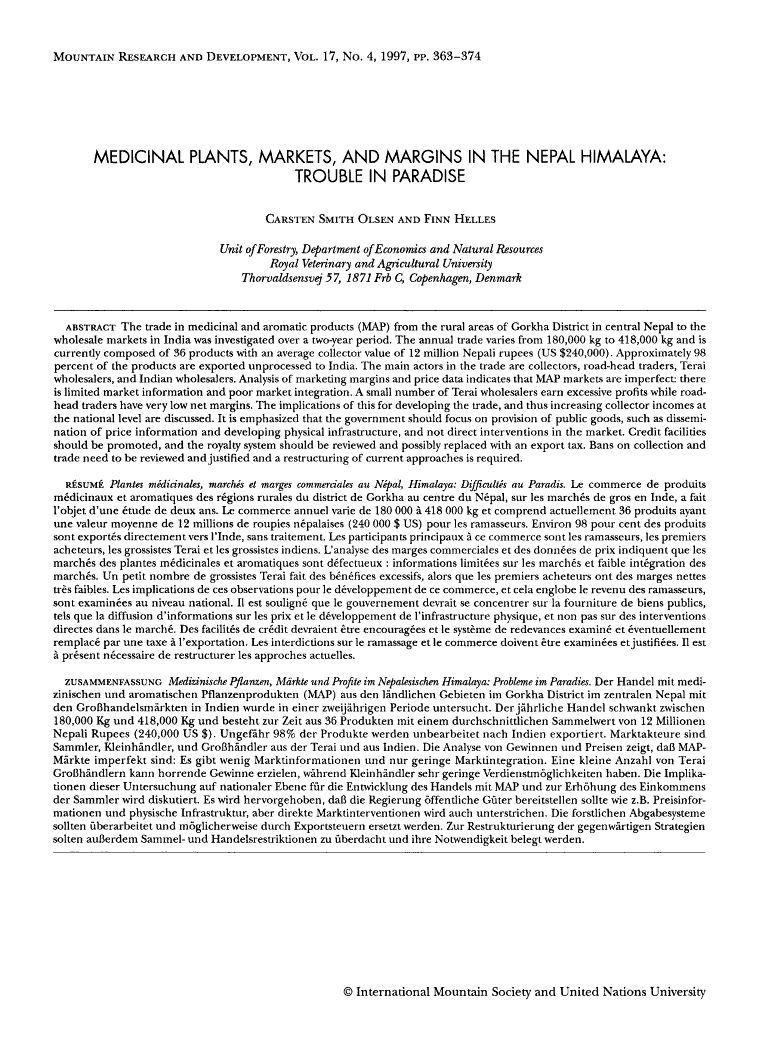
The trade in medicinal and aromatic products (MAP) from the rural areas of Gorkha District in central Nepal to the wholesale markets in India was investigated over a two-year period. The annual trade varies from 180,000 kg to 418,000 kg and is currently composed of 36 products with an average collector value of 12 million Nepali rupees (US $240,000). Approximately 98 percent of the products are exported unprocessed to India. The main actors in the trade are collectors, road-head traders, Terai wholesalers, and Indian wholesalers. Analysis of marketing margins and price data indicates that MAP markets are imperfect: there is limited market information and poor market integration. A small number of Terai wholesalers earn excessive profits while roadhead traders have very low net margins. The implications of this for developing the trade, and thus increasing collector incomes at the national level are discussed. It is emphasized that the government should focus on provision of public goods, such as dissemination of price information and developing physical infrastructure, and not direct interventions in the market. Credit facilities should be promoted, and the royalty system should be reviewed and possibly replaced with an export tax. Bans on collection and trade need to be reviewed and justified and a restructuring of current approaches is required. /// Le commerce de produits médicinaux et aromatiques des régions rurales du district de Gorkha au centre du Népal, sur les marchés de gros en Inde, a fait l'objet d'une étude de deux ans. Le commerce annuel varie de 180 000 à 418 000 kg et comprend actuellement 36 produits ayant une valeur moyenne de 12 millions de roupies népalaises (240 000 $ US) pour les ramasseurs. Environ 98 pour cent des produits sont exportés directement vers l'Inde, sans traitement. Les participants principaux à ce commerce sont les ramasseurs, les premiers acheteurs, les grossistes Terai et les grossistes indiens. L'analyse des marges commerciales et des données de prix indiquent que les marchés des plantes médicinales et aromatiques sont défectueux: informations limitées sur les marchés et faible intégration des marchés. Un petit nombre de grossistes Terai fait des bénéfices excessifs, alors que les premiers acheteurs ont des marges nettes très faibles. Les implications de ces observations pour le développement de ce commerce, et cela englobe le revenu des ramasseurs, sont examinées au niveau national. Il est souligné que le gouvernement devrait se concentrer sur la fourniture de biens publics, tels que la diffusion d'informations sur les prix et le développement de l'infrastructure physique, et non pas sur des interventions directes dans le marché. Des facilités de crédit devraient être encouragées et le système de redevances examiné et éventuellement remplacé par une taxe à l'exportation. Les interdictions sur le ramassage et le commerce doivent être examinées et justifiées. Il est à présent nécessaire de restructurer les approches actuelles. /// Der Handel mit medizinischen und aromatischen Pflanzenprodukten (MAP) aus den ländlichen Gebieten im Gorkha District im zentralen Nepal mit den Großhandelsmärkten in Indien wurde in einer zweijährigen Periode untersucht. Der jährliche Handel schwankt zwischen 180,000 Kg und 418,000 Kg und besteht zur Zeit aus 36 Produkten mit einem durchschnittlichen Sammelwert von 12 Millionen Nepali Rupees (240,000 US $). Ungefähr 98% der Produkte werden unbearbeitet nach Indien exportiert. Marktakteure sind Sammler, Kleinhändler, und Großhändler aus der Terai und aus Indien. Die Analyse von Gewinnen und Preisen zeigt, daß MAP-Märkte imperfekt sind: Es gibt wenig Marktinformationen und nur geringe Marktintegration. Eine kleine Anzahl von Terai Großhändlern kann horrende Gewinne erzielen, während Kleinhändler sehr geringe Verdienstmöglichkeiten haben. Die Implikationen dieser Untersuchung auf nationaler Ebene für die Entwicklung des Handels mit MAP und zur Erhöhung des Einkommens der Sammler wird diskutiert. Es wird hervorgehoben, daß die Regierung öffentliche Güter bereitstellen sollte wie z.B. Preisinformationen und physische Infrastruktur, aber direkte Marktinterventionen wird auch unterstrichen. Die forstlichen Abgabesysteme sollten überarbeitet und möglicherweise durch Exportsteuern ersetzt werden. Zur Restrukturierung der gegenwärtigen Strategien solten außerdem Sammel- und Handelsrestriktionen zu überdacht und ihre Notwendigkeit belegt werden.